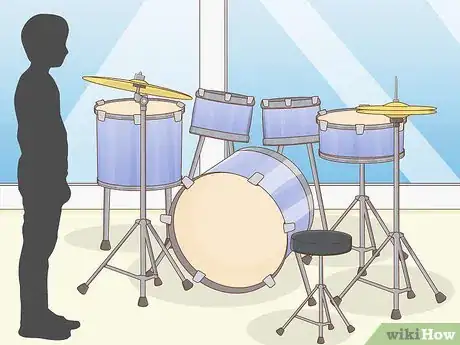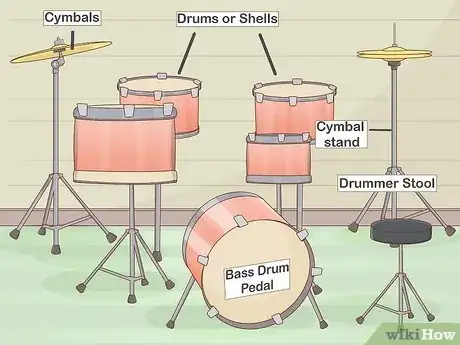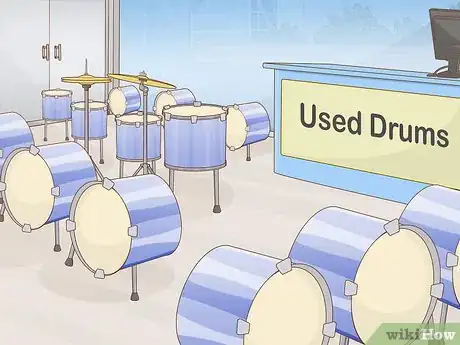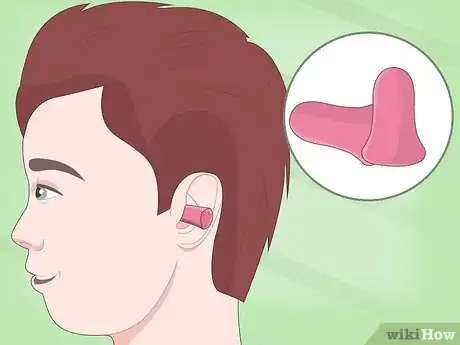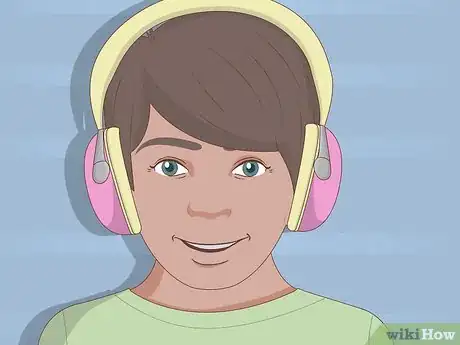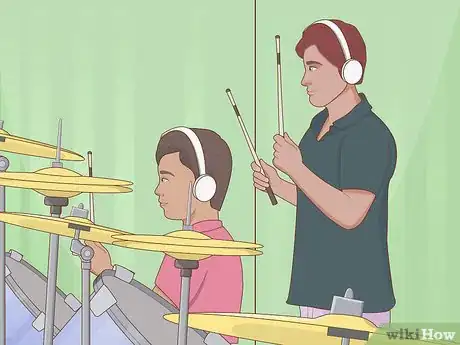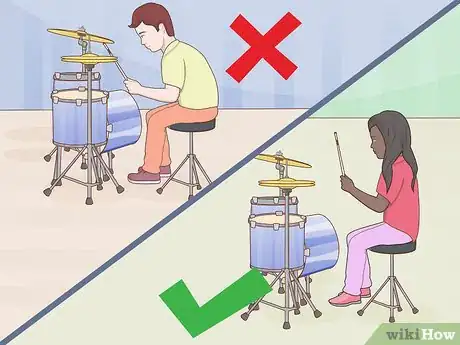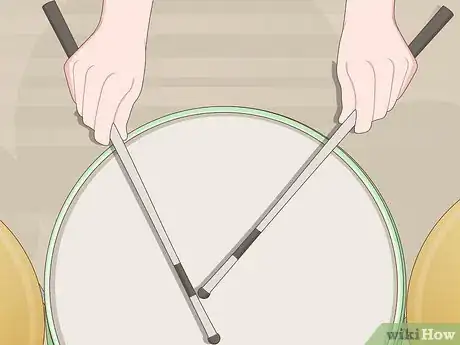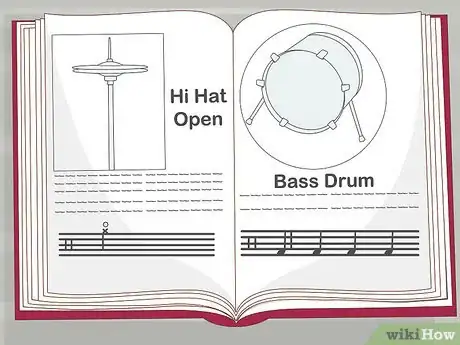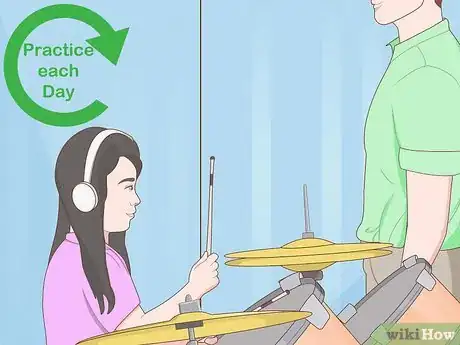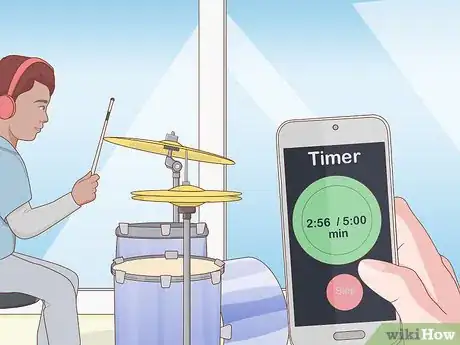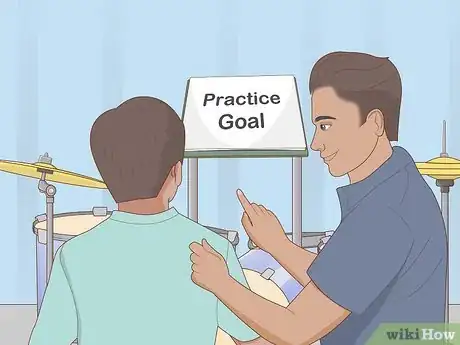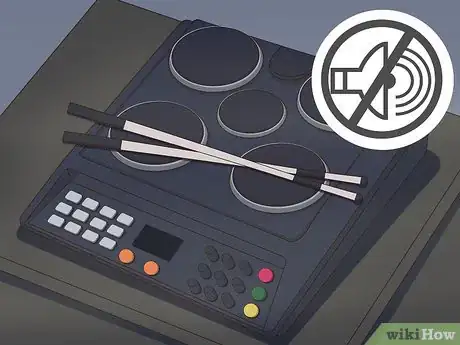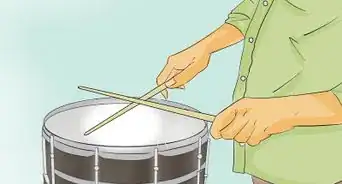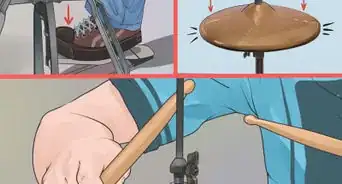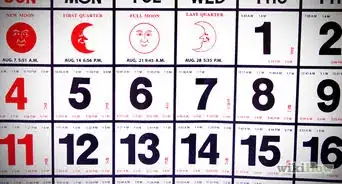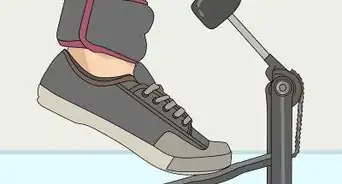This article was co-authored by Matt Khoury, a trusted member of wikiHow's volunteer community. Matt Khoury is a seasoned drummer with over 25 years of experience. He started playing in high-school band and at church, which expanded into opportunities to play with bands in front of thousands of people across the United States.
There are 14 references cited in this article, which can be found at the bottom of the page.
This article has been viewed 56,273 times.
Learn more...
Playing the drum set can be a rewarding and enriching activity for children of all ages. Drumming teaches children hand-eye coordination and appreciation of musical structures, and it gives them a way to express themselves. To help foster your child’s interest and abilities, be sure to provide them with an appropriate drum set for their age and size, a private instructor, and other instruction resources. Help your child maintain a positive attitude toward practicing by scheduling short practice sessions and creating obtainable goals. The right resources and a positive outlook will encourage your child to continue to play, practice, and have fun!
Steps
Selecting the Right Drum Set for Your Child
-
1Purchase a child-sized drum set. Young children or children who are small for their age may have a difficult time playing a regular, full-sized drum set. Smaller drum sets for junior drummers can be purchased online and at department stores, toy stores, and music shops. These smaller sets are similar to regular-sized drum sets and usually feature a small-scale bass drum, snare drum, a cymbal, and drum sticks.
- Complete junior drum sets can cost around $300.[1] Some toy drum sets at a toy store can cost between $80 and $150.
- Consider renting a drum set for your young drummer. Many music stores offer daily, weekly, or monthly rentals. A daily rental can cost around $175, while a monthly rental can cost around $300.[2] Be sure to ask if there are delivery fees for the drum set. Both a delivery and a pick-up fee can cost around $40 for each trip.
-
2Buy an all-inclusive drum set for a taller, older child. Drum sets can be costly, so you may wish to purchase an all-inclusive, inexpensive drum set for a young drummer until you know that the child will take an interest in playing. A regular size, full drum set will be able to comfortably accommodate a taller child. An all-inclusive drum set should include the drums, also called the shells, along with cymbals, cymbal stands, a bass drum pedal, and a drummer’s stool.[3]
- The cymbals and other hardware may be flimsy in the cheaper sets and may bend with frequent use.[4]
- Be sure to read the descriptions of what is included if you are purchasing a drum set online to ensure that you are getting all the components your child needs.
Advertisement -
3Consider buying a used drum set. A properly treated, used drum set can be a less expensive option for a young drummer. Many music stores sell used instruments, and a reputable store will carefully survey each used instrument to ensure that they are selling a quality product to their customers. Be on the lookout for cracked drum shells and cymbals, and make sure that the hardware and cymbal stands are not bent.[5]
- If there is a crack in a cymbal, it will get worse over time. Sometimes there are small cracks in the cymbal’s circular grooves and the center hole, so pay close attention to this area when looking at a used set.[6]
Getting Your Child Started
-
1Protect their hearing with earplugs. Before the child begins playing the drums, make sure that they have adequate protection for their ears.[7] Soft foam or plastic ear plugs fit directly into your child’s ear canal and are an inexpensive and portable option.
- To insert foam earplugs, roll the earplug between your hands to create a narrow tube shape. Gently place one end into the ear canal and hold it there for 20 to 30 seconds as it expands. If done properly, your child’s voice should sound muffled to them. Be sure to teach your child how to properly insert the earplugs before playing the drums.[8]
- Be sure that their pediatrician is aware that they will be taking lessons and ask if they have any recommendations for protecting the child’s hearing.
-
2Opt for earmuffs to protect their ears. Earmuffs resemble headphones and completely cover your child’s ear. They are more expensive than earplugs, but they are easy for your child to put on quickly. Visit a local department store or music store so your child can try on earmuffs to find the right size and fit. Be sure that the earmuffs are not too loose and that they seal properly around your child’s ears.
- If you child wears glasses, make sure that the earmuffs comfortably fit over them.[9]
-
3Find a private tutor for your child. A young drummer whose early development consists of undisciplined and unstructured playing will develop bad habits regarding technique, musicianship, and practice. A private instructor will keep the student's technique solid and will establish benchmarks that encourage the child to focus their practice. A weekly one-hour or 30-minute session is plenty to provide the student with direction and instruction in their drumming.
- Visit a music shop in your town to see if they offer lessons or if they can put you in touch with a local instructor. Approach a local high school band director or faculty member at a university music department to see if any students or instructors offer private drum lessons.
- Lessons can be between $10 to $60 dollars for 30 minutes of instruction, but this price can vary depending on your location and the instructor’s training and expertise.[10]
-
4Provide additional instruction resources. In addition to hiring a tutor, it is important to provide your child with other resources to provide well-rounded and thorough instruction. Method books detail the basics of drumming and provide practice tips and new rhythms to try. Instruction videos are also excellent tools for helping a child understand the fundamentals of drumming. Ask your child’s instructor or an expert at a local music shop for recommendations.
- Most private instructors will provide method books for your child.
- DVD and online drum lessons are other helpful resources in teaching drums to a child.
Learning Basic Drumming Skills
-
1Maintain good posture. After ensuring that your child has the correct drum set for their size and age, you will want to make sure that they are practicing good posture when they play. Poor posture may cause your child’s back or neck to ache, and this discomfort will not encourage your child to keep practicing. A proper position will also make it easier for your child to access all of the sections of the drum set.[11]
- Don’t slouch! Encourage your child to sit up straight, which will help reduce pressure on their lower back. Adjust the height of the drummer’s stool so that your child’s feet comfortably reach the pedals. Their knees should rest at an angle between 90 and 110 degrees.
-
2Hold the drum sticks correctly. To prevent strain and to help your child play correctly, it is important that your child hold the drumsticks properly. The child should hold the drumstick a third of the way up the stick. They should grip it between their thumb and index finger to achieve a proper swing. The others fingers should be wrapped around the drumstick gently, with the ring and pinky finger resting beneath the stick.[12] As your child progresses, they may learn various drumstick grips.
-
3Learn basic drumming notations. Although it is not necessary for a child to know how to read music before they begin to learn the drums, it is important that they review and understand sheet music as they progress. The child’s method books, instructional videos, and tutor should cover these basics during their lessons. Begin by introducing basic music notations and symbols for standard music before moving on to percussion notations. Most drumming notations use the lines and spaces in a bar of music to represent the various drums of a drum kit.[13]
- Review musical notations with your child. Ask them to identify various musical notes and see if they can count the beat.
-
4Practice basic rhythms. Having good rhythm is crucial for becoming a good drummer. Encourage your child to practice a few bars of basic rhythms each day to help build this foundation. They should practice various rhythms slowly so that they are accurate and in time. Remind your child that it is not about speed, but rather feeling the beat correctly.[14]
Encouraging a Child to Practice
-
1Establish short practice sessions. Long practice sessions may be overwhelming for a young drummer, which may cause your child to lose interest in the instrument or confidence in their abilities. To keep the practice sessions fun and encouraging, plan the practice schedule with your child. Asking for their input helps the child feel engaged and in control. Recommend that they start out with short practice sessions each day for 5, 10, or 15 minutes.[15]
- As the child gets older and improves, encourage them to practice longer or until they feel like they have accomplished something.
-
2Set practice goals. Ask your child to think about the goals they have for each practice session. One practice session may include learning two bars of a new song, while another session may be geared toward improving drumming eighth note beats.[16] Having obtainable goals will help the child feel successful and confident after each practice session. Practice will be associated with positive emotions and achievements rather than frustration or boredom.
-
3Give the child a drum pad for silent practice. Drum pads are excellent tools for practicing in relative silence.[17] They have striking surfaces made from gum rubber or neoprene, and can be held in the child's lap or placed on a snare drum stand during practice. Having a drum pad available will allow the child to practice when playing loudly on a drum set would not be appropriate.
-
4Be positive. Support your child and inspire them to keep practicing by being positive and encouraging. Let them know that you are proud of them and that they are doing a great job.
- Take an interest in their music, and ask them about what they are currently working on in their lessons.
- If your child seems frustrated or upset with their progress, take that opportunity to praise their progress and accomplishments. “I heard you were practicing the new song you learned during your last lesson. Your sixteenth notes sound great! Keep up the great work.” Your child’s confidence will grow, and they will be motivated to continue practicing.
-
5Keep it fun. Introduce new ways to keep practice fun and exciting. Take your child to a music concert, or set-up an at-home concert where your child performs for your family, the neighbors, their toys—anyone! Establish a reward system for the amount of time they spend practicing. If they practice for 3 hours each week, you could reward them with more allowance money or a trip to their favorite candy shop.[18] Changing up the routine of practice can make it more fun and exciting for your child.
Expert Q&A
-
QuestionDo you need drum lessons?
 Matt KhouryMatt Khoury is a seasoned drummer with over 25 years of experience. He started playing in high-school band and at church, which expanded into opportunities to play with bands in front of thousands of people across the United States.
Matt KhouryMatt Khoury is a seasoned drummer with over 25 years of experience. He started playing in high-school band and at church, which expanded into opportunities to play with bands in front of thousands of people across the United States.
Veteran Drummer Finding an amateur or professional drummer to teach your child can be very helpful early on. The basics of drumming are centered around a few principles, and a good drumming instructor will make sure your child is building a solid foundation. Plus, a teacher can personalize instruction and be a really great motivator for your child!
Finding an amateur or professional drummer to teach your child can be very helpful early on. The basics of drumming are centered around a few principles, and a good drumming instructor will make sure your child is building a solid foundation. Plus, a teacher can personalize instruction and be a really great motivator for your child! -
QuestionWhat basic rhythms can you teach a child?
 Matt KhouryMatt Khoury is a seasoned drummer with over 25 years of experience. He started playing in high-school band and at church, which expanded into opportunities to play with bands in front of thousands of people across the United States.
Matt KhouryMatt Khoury is a seasoned drummer with over 25 years of experience. He started playing in high-school band and at church, which expanded into opportunities to play with bands in front of thousands of people across the United States.
Veteran Drummer You can start by teaching your kid the standard 4/4 rhythm, where the hi-hat hand plays sequential and evenly spaced quarter notes, 1, 2, 3, 4; the kick drum hits on beats 1 and 3; and the snare drum hits on beats 2 and 4. The biggest challenge your kid will face will be learning to move each limb independently. With enough practice, though, they'll be able to master these basic rhythms.
You can start by teaching your kid the standard 4/4 rhythm, where the hi-hat hand plays sequential and evenly spaced quarter notes, 1, 2, 3, 4; the kick drum hits on beats 1 and 3; and the snare drum hits on beats 2 and 4. The biggest challenge your kid will face will be learning to move each limb independently. With enough practice, though, they'll be able to master these basic rhythms. -
QuestionHow can I be a professional drummer?
 Community AnswerYou can join music groups and practice as much as you can. You can also opt to get a degree in music, more specifically in percussion studies.
Community AnswerYou can join music groups and practice as much as you can. You can also opt to get a degree in music, more specifically in percussion studies.
Things You'll Need
- Drum set
- Drum sticks
- Earplugs or earmuffs
References
- ↑ http://takelessons.com/blog/how-much-does-a-drum-set-cost
- ↑ https://www.drumsetc.com/catalog/instrument-rentals-0
- ↑ http://www.schoolofrock.com/blog/how-to-buy-a-first-drum-set
- ↑ http://www.schoolofrock.com/blog/how-to-buy-a-first-drum-set
- ↑ http://www.schoolofrock.com/blog/how-to-buy-a-first-drum-set
- ↑ http://www.schoolofrock.com/blog/how-to-buy-a-first-drum-set
- ↑ http://kidshealth.org/en/parents/ears.html#
- ↑ https://www.noisyplanet.nidcd.nih.gov/parents/protect-your-childs-hearing
- ↑ https://www.noisyplanet.nidcd.nih.gov/parents/protect-your-childs-hearing
- ↑ http://takelessons.com/blog/cost-of-drum-lessons-for-kids
- ↑ http://www.rockdrummingsystem.com/underground/drum-articles/proper-posture-for-drummers.php
- ↑ https://www.youtube.com/watch?v=0HFW7yplSBw
- ↑ http://web.mit.edu/merolish/Public/drums.pdf
- ↑ http://www.rockdrummingsystem.com/underground/drum-lessons/learn-how-to-count-time.php
- ↑ http://www.npr.org/sections/deceptivecadence/2012/06/18/155282684/getting-kids-to-practice-music-without-tears-or-tantrums
- ↑ http://www.npr.org/sections/deceptivecadence/2012/06/18/155282684/getting-kids-to-practice-music-without-tears-or-tantrums
- ↑ http://thehub.musiciansfriend.com/drum-buying-guides/the-beginners-guide-to-buying-drums-and-percussion
- ↑ http://www.parents.com/parenting/better-parenting/positive/how-to-motivate-kids-to-practice-for-music-lessons/
